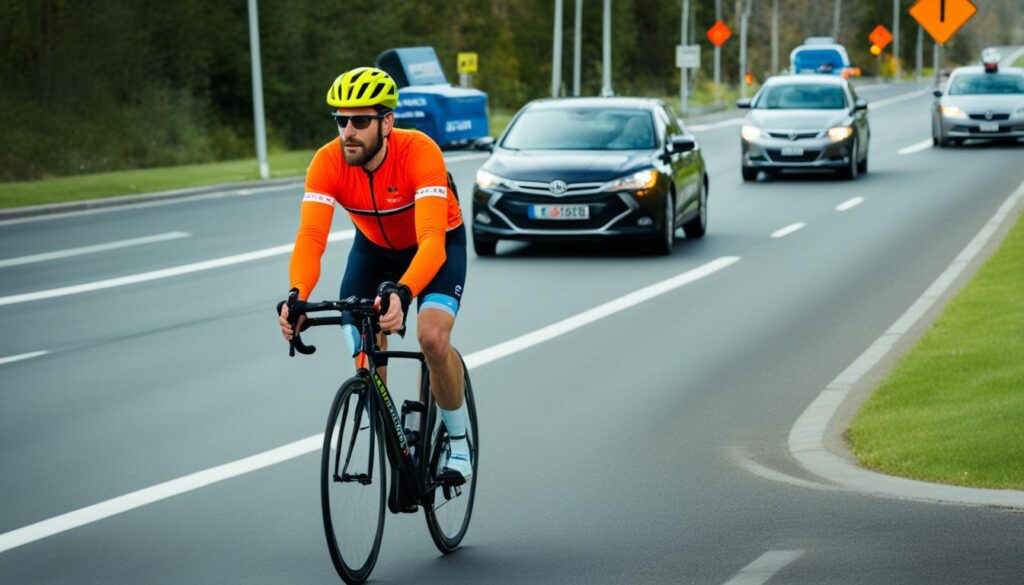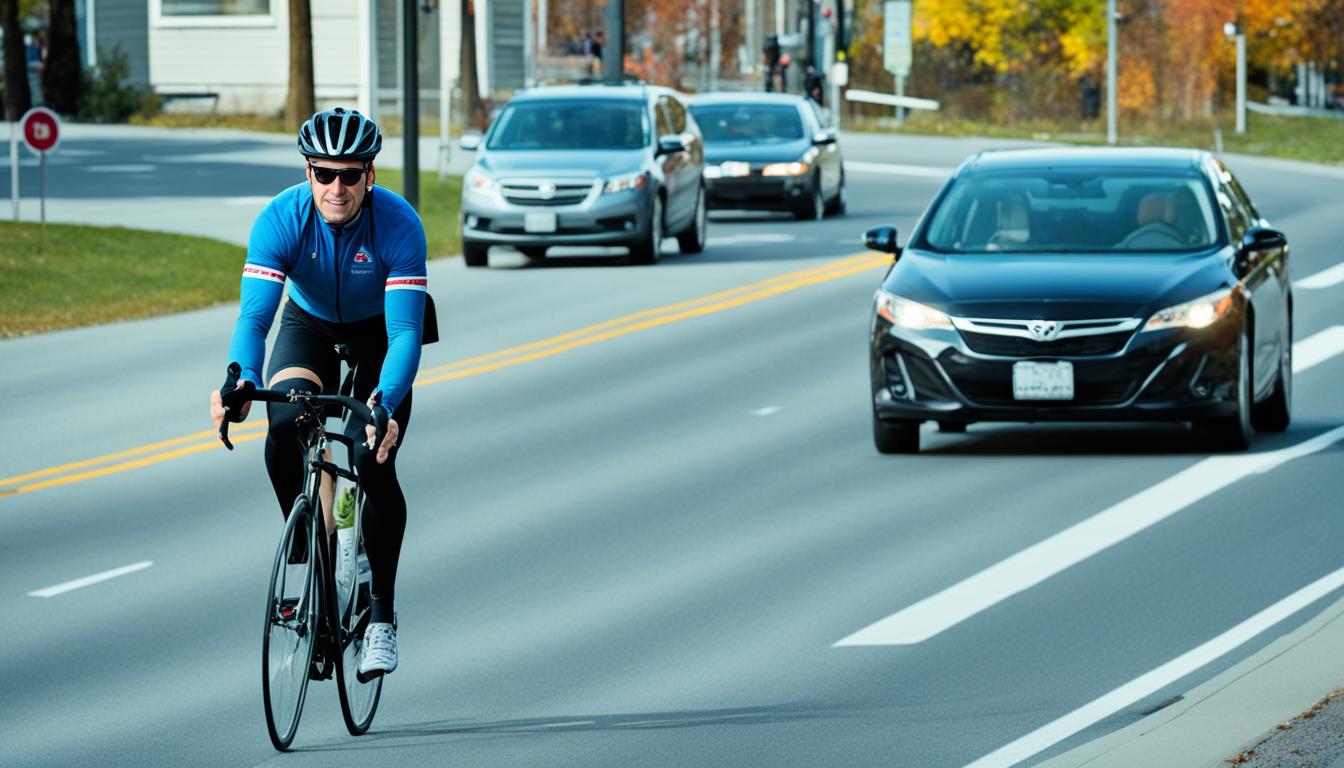Did you know that more than half of Canadians participate in some form of cycling activity each year?[1] With cycling becoming increasingly popular, it is essential for both drivers and pedestrians to understand how to share the road safely. Road safety is a shared responsibility, and by following a few simple practices, we can create a harmonious and secure environment for all road users.
Key Takeaways:
- Drivers need to exercise due diligence and yield to pedestrians, especially in crosswalks and school zones.
- Cyclists have the right to ride about one meter from the curb or parked cars, and drivers must pass them at a safe distance of one meter.
- Cyclists should use bike lights and hand signals, and both cyclists and pedestrians should communicate and follow road etiquette.
- Motorists must respect the rights of cyclists and pedestrians and avoid common annoyances, such as cutting off cyclists or honking unnecessarily.
- By cooperating, respecting road safety guidelines, and promoting a respectful driving culture, we can make our roads safer for everyone.
Read on to discover practical tips and guidelines for sharing the road with cyclists and pedestrians in Canada.
[1]
Source: Cycling Canada. “Cycling Participation in Canada.”
Sharing the Road with Pedestrians
As drivers, we have a shared responsibility with pedestrians to ensure road safety. Whether you’re behind the wheel or walking on foot, it’s crucial to prioritize the well-being of everyone on the road. To facilitate a safe road-sharing experience, both pedestrians and drivers should follow these guidelines:
Pedestrians:
- Before stepping onto the roadway, always ensure that drivers have seen you. Make eye contact or wait for them to acknowledge your presence.
- Use crosswalks whenever possible and wait for the appropriate signal before crossing. Cross only when it’s safe to do so.
- When walking in residential areas or school zones, be mindful of children and their unpredictable movements. Stay alert and cautious.
- Remember to utilize pedestrian crossovers and school crossings. Drivers should stop and yield to pedestrians crossing at these designated areas.
- Community safety zones are established to protect pedestrians. Be aware of these zones and follow any specific rules or speed limits.
- If you are a senior or have a disability, drivers should exercise extra patience and give you the time needed to safely cross the road.
Drivers:
- Always be cautious and yield to pedestrians when they are crossing the road. Exercise patience and wait for them to complete their crossing.
- Keep a watchful eye for children, especially in school zones and residential areas. Children may not always be aware of traffic laws and can be unpredictable.
- Give your full attention to the road and avoid distractions. Keep your focus on pedestrian crossings, crosswalks, and any signage indicating their presence.
- Observe and respect all crosswalks. Stop and yield to pedestrians who are waiting to cross or already in the crosswalk.
- Be mindful of the specific rules and regulations within community safety zones. Adhere to any imposed speed limits and exercise caution accordingly.
By working together and following these guidelines, pedestrians and drivers can contribute to a safer road environment. Let’s prioritize road safety and respect each other’s presence on the road.
| Key Points | Benefits |
|---|---|
| Ensuring drivers have seen pedestrians before entering the roadway | Reduces the risk of accidents and collisions |
| Drivers yielding to pedestrians at crosswalks | Creates a safe and efficient flow of traffic |
| Watching for children and being cautious in school zones | Protects vulnerable road users and prevents potential accidents |
| Being aware of community safety zones | Promotes overall road safety and compliance with regulations |
| Exercising patience and allowing pedestrians, especially seniors or those with disabilities, time to cross | Fosters inclusivity and ensures everyone can safely navigate the road |
Sharing the Road with Cyclists
When it comes to sharing the road with cyclists, drivers play a crucial role in ensuring the safety of everyone on the road. Understanding the rules and guidelines for interacting with cyclists can help prevent accidents and promote a harmonious road-sharing experience.
Cyclists in Canada have the right to ride close to the right-hand side of the road or the curb. However, they can use any part of the lane if it is necessary for their safety. As a driver, it is important to be aware of cyclists and respect their space on the road.
When passing a cyclist, it is important to maintain a minimum distance of one meter. This allows for a safe passing distance and reduces the risk of collisions. Always check for oncoming traffic before overtaking a cyclist and ensure that there is enough space to pass safely.
Intersections can be particularly challenging when it comes to sharing the road with cyclists. When making right turns or driving through intersections, drivers must be cautious and check for cyclists. They may be approaching from the right side or passing through the intersection. Being aware of their presence can help prevent accidents and ensure a smooth flow of traffic.
Respecting bike lanes is crucial for both drivers and cyclists. Bike lanes provide a designated space for cyclists to ride safely. As a driver, it is important to avoid entering or blocking bike lanes, as this can put cyclists at risk. When turning right, be mindful not to cut off cyclists who may be continuing straight or turning from the bike lane.
Bike boxes and sharrows are additional road features that drivers should watch out for when sharing the road with cyclists. Bike boxes are designated areas at intersections that allow cyclists to wait ahead of motor vehicle traffic. Sharrows, or shared lane markings, indicate that cyclists and drivers should share the same lane. These features help create a safer environment for cyclists and promote a better understanding of road-sharing dynamics.
| Cyclist Safety Guidelines | Driver Safety Guidelines |
|---|---|
| Ride close to the right-hand side of the road or curb | Give cyclists at least one meter of passing distance |
| Use any part of the lane for safety | Check for cyclists at intersections |
| Respect bike lanes and don’t cut off cyclists when turning right | Avoid entering or blocking bike lanes |
| Observe bike boxes and sharrows | Be aware of and respect cyclists’ presence |
By following these guidelines, drivers can contribute to a safer road environment for cyclists and other road users. Together, we can ensure that everyone can enjoy the benefits of cycling while maintaining a respectful and safe road-sharing experience.

Sharing the Road with Motorcycles and Limited-Speed Motorcycles
When driving on the road, it is crucial to be mindful of motorcycles and limited-speed motorcycles. These vehicles are more vulnerable in case of a collision due to their lack of protection. As responsible drivers, we must take extra precautions to ensure their safety. There are a few key points to remember:
Watch Out for Blind Spots
Large commercial vehicles like trucks and buses have significant blind spots. It is essential to be aware of these blind spots and adjust your driving accordingly. When changing lanes or making turns, always check your mirrors and blind spots for motorcycles. Remember, a quick glance might save a life.
Allow for Longer Stopping Distance
Motorcycles and limited-speed motorcycles require a longer stopping distance compared to cars. Therefore, it is crucial to maintain a safe following distance to allow for sudden stops. By leaving enough space, you give yourself and the motorcyclist enough time to react to any unexpected situations that may arise.
“A motorcycle is not just a means of transportation; it is a symbol of freedom and adventure. As drivers, it is our responsibility to protect their right to ride safely on the road.” – Anonymous
Exercise Caution During Turns
Wide turns can pose a significant risk to motorcyclists. Always double-check for approaching motorcycles before making a turn, especially when turning right. Take an extra moment to ensure there are no motorcyclists in your blind spot. Being patient and cautious during turns can prevent accidents and save lives.
Remember, motorcycles and limited-speed motorcycles are an integral part of our roadways. By being aware of their presence, respecting their rights, and following these safety practices, we can create a safer environment for all road users.
Sharing the Road with Large Commercial Vehicles
When it comes to sharing the road, it’s essential for drivers to be aware of how to safely navigate around large commercial vehicles such as tractor-trailers and buses. These vehicles have unique characteristics that require extra caution and attention from all road users. In this section, I’ll discuss the key considerations for sharing the road with large commercial vehicles, including blind spots, stopping distance, and wide turns.
Understanding Blind Spots
Large commercial vehicles have significant blind spots, also known as “no-zones,” where the driver’s visibility is severely limited. These blind spots exist on the sides, rear, and front of the vehicle and can extend up to several meters. As a driver sharing the road, it is crucial to stay out of a commercial vehicle’s blind spots to avoid accidents. Always be aware of these blind spots and try to position your vehicle where the truck driver can see you.
Allow Sufficient Stopping Distance
Large commercial vehicles require a longer stopping distance due to their size and weight. When driving near these vehicles, give them ample space and avoid abrupt braking or cutting them off, as they may not be able to stop in time. Remember, maintaining a safe following distance is crucial to allow enough time for both you and the commercial vehicle to come to a complete stop if necessary.
Caution for Wide Turns
Large commercial vehicles have a wider turning radius compared to smaller vehicles. When you see a commercial vehicle with its turn signal on, be patient and give it enough room to complete the turn safely. Avoid attempting to pass the vehicle on the right side, as it may swing wide to the left during the turn. By being cautious and allowing for these wider turns, you can greatly reduce the risk of accidents and ensure a smoother flow of traffic on the road.
As you share the road with large commercial vehicles, remember to always exercise patience, maintain a safe distance, and be vigilant. By understanding their blind spots, allowing sufficient stopping distance, and being cautious around wide turns, we can create a safer road environment for everyone.
Common Annoyances on the Road: Cyclists and Pedestrians
With the increasing popularity of cycling, it’s important to address common annoyances on the road involving cyclists and pedestrians. Road etiquette plays a significant role in ensuring a safe and respectful road-sharing experience for all. Let’s take a closer look at some of these annoyances.
Annoyance 1: Disregard of Road Rules
Unfortunately, some cyclists may choose to disregard road rules, which can create unsafe situations for everyone. One common example is cyclists wearing headphones or talking on their cell phones while riding. These distractions can diminish their ability to hear and respond to traffic cues, posing a risk to themselves and others on the road. It is crucial for cyclists to prioritize their safety and follow road rules by avoiding distractions.
Annoyance 2: Lack of Pedestrian Awareness
Pedestrians also play a vital role in road safety. It’s essential for pedestrians to remember to look both ways before crossing the street and not walk out into traffic without checking for oncoming vehicles. By neglecting to follow these basic safety practices, pedestrians jeopardize their own safety and increase the risk of accidents involving cyclists and drivers.
In Canada, road safety is a shared responsibility. Both cyclists and pedestrians must communicate and follow road etiquette to ensure a safe and respectful road-sharing experience.
Annoyance 3: Failure to Communicate
A lack of communication between cyclists and pedestrians can lead to misunderstandings and dangerous situations. Clear communication, both verbally and through hand signals, is vital for indicating intentions and avoiding collisions. Cyclists should use hand signals to indicate their turns, and pedestrians should make eye contact with drivers before crossing the street, ensuring they are acknowledged and it’s safe to proceed.
Annoyance 4: Ignoring Road Etiquette
Road etiquette is an essential aspect of safe road-sharing. It is crucial for both cyclists and pedestrians to adhere to road etiquette by respecting traffic signals, yielding to the right of way when necessary, and being aware of their surroundings. These small acts of consideration contribute to a harmonious and safe road environment.
Annoyance 5: Distracted Walking and Riding
Distracted walking and riding can significantly compromise road safety for both pedestrians and cyclists. Pedestrians engrossed in their smartphones or other distractions may not pay attention to their surroundings, making them vulnerable to accidents. Similarly, cyclists who are preoccupied with distractions are less likely to react swiftly to potential hazards. All road users must prioritize their attention and stay focused on the road.
By addressing these common annoyances and promoting road etiquette, cyclists and pedestrians can contribute to a safer road-sharing experience for everyone.
Common Annoyances on the Road: Motorists
As we discuss the common annoyances on the road, it is essential to acknowledge that motorists also contribute to these issues. While we often focus on the behaviors of cyclists and pedestrians, it is crucial to address the role of motorists in creating a safe and respectful road-sharing experience.
One common annoyance involving motorists is unnecessary honking directed at cyclists. Honking can startle and intimidate cyclists, leading to potential accidents or conflicts. It is important for motorists to understand that cyclists have the right to be on the road and should be treated with respect.
Another issue is when motorists cut off cyclists while making turns. Cutting off cyclists not only puts them in immediate danger but also creates a hostile environment on the road. Motorists should always check their blind spots and give cyclists sufficient space when turning.
Running red lights is a dangerous behavior that some motorists engage in. This not only puts their own lives at risk but also endangers cyclists and pedestrians who may be following the appropriate traffic signals. Motorists must always adhere to traffic laws and respect the safety of all road users.
Furthermore, crossing walkways and not respecting streetcar doors can disrupt the flow of traffic and jeopardize the safety of pedestrians. Motorists should be mindful of pedestrian crossings and yield the right of way when required. Additionally, respecting streetcar doors prevents accidents and ensures the smooth operation of public transportation.
“As a motorist, I understand the frustrations we sometimes face on the road. However, it is crucial for us all to follow traffic laws, be patient, and show respect to our fellow road users.”
By addressing these common annoyances and promoting responsible driving, we can create a safer road-sharing experience for everyone. Let’s be mindful of our actions as motorists and strive to build a harmonious and respectful road environment.

Simple Tips for a Safer Road-Sharing Experience
Ensuring a safe road-sharing experience for everyone requires the cooperation and awareness of both cyclists and drivers. By following these simple tips, we can enhance the overall safety on the road:
- Use Bike Lights: Cyclists should always use bike lights, especially when riding during dark conditions. Bike lights significantly increase visibility for both drivers and pedestrians, reducing the risk of accidents.
- Use Hand Signals: When turning or changing lanes, cyclists should use clear and well-defined hand signals to communicate their intentions to drivers and other road users. Hand signals help establish a predictable flow of traffic and enhance overall safety.
- Effective Communication: Communication is a key aspect of road-sharing. Cyclists can verbally communicate with drivers by using simple phrases like “on your left” when passing, providing a clear understanding of their intentions. Effective communication minimizes confusion and helps all road users navigate safely.
By implementing these simple tips, we can create a safer road-sharing experience, fostering mutual respect between cyclists and drivers.
Conclusion
As we wrap up our discussion on sharing the road with cyclists and pedestrians, it is clear that promoting cycling in Canada goes hand in hand with road safety and respectful driving. Cooperation among all road users is essential for creating a safe and harmonious environment.
By following the tips provided throughout this article and being mindful of other road users, we can contribute to a safer and more respectful driving experience. Whether we are drivers, cyclists, or pedestrians, it is our responsibility to adhere to road safety guidelines and show respect towards one another.
Let us work together to make our roads safe for everyone. By fostering a culture of mutual respect and understanding, we can encourage more people to embrace cycling as a sustainable and healthy mode of transportation. Remember, safe roads benefit everyone in the community.
